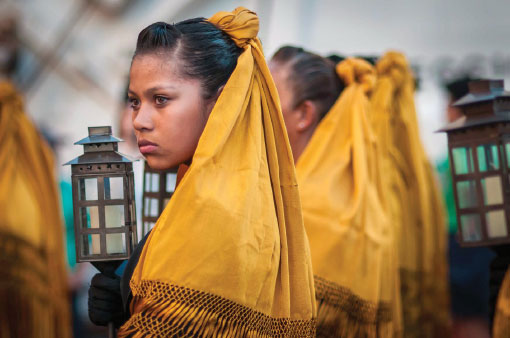This exhibition was conceived for the French film festival Regards d’Ailleurs, hich dedicated its 17th edition to honor Mexican cinematography. In this context, I decided to use the artistic freedom granted by Thierry Méranger, film festival director and president of the supporting association Fenêtre sur Films, to curate an exhibition that would show the richness of Mexican culture through the timeless art of photography.
After a careful study of contemporary artists whose photographic oeuvre has been devoted to exploring Mexico, I selected the style set forward by Eduardo González for the audaciousness of his shots as well as his passionate – and also playful – curiosity to reveal this country’s colorful web of societal contrasts and contradictions.
Immersed in his extensive photography archives, I began to compile a selection that would present Mexico through an image-based exploration of both popular and lesser-known Mexican traditions based on faith. I was fully aware that illustrating this theme in France – a country that is proudly secular at its base – was a rather bold move. The desire to produce a thought-provoking exhibition, however, prevailed in the end.
Miradas de fe / Regards de foi (which roughly translates to Glances of Faith) was conceived as a bilingual exhibition (Spanish-French) and divided into four chapters: the world-famous Día de Muertos (Day of the Dead), celebrated in the city of Pátzcuaro, Michoacán and in the millenary town of San Andrés Mixquic at the outskirts of Mexico City; the traditional Procesión del Silencio (Procession of Silence) that takes place in one of the most important cities in the geographical center of the Mexican territory as it commemorates in absolute silence and great devotion the Stations of the Cross; the cult to the mystical shaman known as Niño Fidencio who acquired great fame when, in the 1920s, a Mexican president traveled to the northern town of Espinazo in search for his help; and the festive Calendas in the colonial city of Oaxaca, where the colorful joy brought by these popular celebrations boasts of its religious origins.
It was a true privilege to be offered the Chapelle de l’Hôtel Dieu as the exhibition space at this memorable occasion in the French city of Dreux. Originally consecrated as a church in 1170 by the bishop of Chartres, Jean de Salisbury, it was destroyed several times during periods of war until its final reconstruction in 1630. Thereafter, its livelihood depended on Dreux’s first hospital – l’Hôtel Dieu or Maison-Dieu – until a new medical establishment was opened in 1910 in Saint-Denis. Today, this place offers a truly distinctive exhibition space that combines the elegance of 17th century architecture – framed by the imponent painting by Auguste Hyacinthe Debay, La bataille de Dreux, which the king Louis-Philippe offered to the city of Dreux in 1846 – with the freshness of white cube style exhibition walls. The resulting contrast is quite unique.
My deep-hearted thanks go to every member of the Regards d’Ailleurs film festival for trusting and supporting me in this role; to Eduardo González for believing in my curatorial vision; to the municipal government of Dreux for graciously accepting to host me at the prestigious 17th-century Hôtel Montulé – Maison des Arts during the duration of my artistic residence in this city; to the journalists at L’Écho Républicain for the excellent coverage devoted to this exhibition from its inauguration through its last viewing day; and to each and every one of the film festival attendees – particularly those dedicated cinema students at Lycée Rotrou – who visited Miradas de fe / Regards de foi to learn more about Mexico with curious eyes and open minds.
